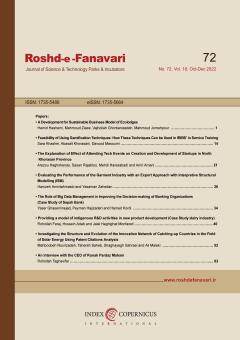Evaluating the performance of the garment industry with an export approach with Interpretive Structural modelling (ISM)
Subject Areas : Technology Transfer and Commercialization of Researches
Hamzeh Amin-Tahmasbi
1
*
![]() ,
Yasaman Zahedan
2
,
Yasaman Zahedan
2
1 - University of Guilan
2 - University of Guilan
Keywords: Performance MeasurementGarment IndustryInterpretive Structural ModellingMICMAC AnalyzeExport,
Abstract :
The garment industry is one of the important and flourishing industries in the country that seems to grow in the export market besides the internal market. It’s considerable that performance measurement is a vital tool for access to basic improvements and it’s important in management. Therefore this research sought to found important and influencer indicators in the garment industry and determine the relationship between these indicators and their preference for each other. For perform this investigation, 35 indicators, obtained from literature review, filtered using questionnaires and experts opinion and then 16 indicators were selected as basic indicators based on Fridman’s method. Using ISM, a meaningful relationship and the importance of indicators were extracted. Penetration power and dependence of indicators determined with the MICMAC analysis. The ISM model showed that the “quality of design”, “planning”, and “applied education with the aim of export increase” indicators have the most impact and they act such as the infrastructure for the model. Also “new product introduction”, “brand promotion”, “increase ordering level”, “marketing”, “effective presence in international markets” and “financial” indicators stand at the top level of the model and are influenced by other indicators. MICMAC analysis showed that “quality of design”,” quality of adaptation”,” planning”, and “applied education with the aim of export increase” have strong driving power but weak dependence power; As a result, these factors are driving in the garment industry and should be a priority for the organization.
1- کیاحسینی، سید محمد؛ عبدالحسینی، سارا، تجزیهوتحلیل وضعیت صنعت نساجی و پوشاک ایران و ارائه راهکارهای احیا و توسعه این صنعت، اتاق اصناف ایران، 1395.
2- حنفی زاده، پیام؛ راسخ، حمیدرضا و میرصالحیان، محمدحسین، مدل ارزیابی عملکرد تلفیقی موردمطالعه صنعت داروسازی، فصلنامه مطالعات مدیریت صنعتی، شماره 26، سال دهم، ۱۳۹۱، 87-114.
3- صفری، سعید؛ عباسی، رضا و سلطانی علیآباد، مژگان، شناسایی عوامل ارزیابی عملکرد کارآفرینی سازمانی، فصلنامه تخصصی رشد فناوری، شماره 46، سال دوازدهم، 1395، 61-67.
4- امام وردی ملک، سعید؛ حسنپور، حسینعلی و نورنگ، احمد، ارائه مدل ارزيابي ناب چابكي زنجيره تأمين پوشاك، فصلنامه علمی-ترویجی (وزارت علوم)، شماره 49، سال هفدهم، 1394.
5- طبیبی، محمدرضا؛ صالحی راد، علی؛ عسکری، محسن و جابری، فاطمه، ارزیابی تطبیقی عوامل عملکرد تجاری صنایع نساجی و چرم کشورهای منتخب و ایران، دهمین کنفرانس ملی مهندسی نساجی ایران، اصفهان، دانشکده مهندسی نساجی دانشگاه صنعتی اصفهان،1394.
6- محمدکاظمی، رضا؛ خوانساری شامخ، ندا و حسینپور، داوود، عوامل حیاتی موفقیت توسعه محصول جدید در صنعت پوشاک (ورزشی)، دوماهنامه مطالعات مدیریت ورزشی، شماره 34، سال هفدهم، ۱۳۹۴، 17-36.
7- آقاجانی، حسنعلی و طالب نژاد، عاطفه، ارائه چارچوبی برای ارزیابی عملکرد مراکز رشد، فصلنامه تخصصی رشد فناوری، شماره 19، سال پنجم، ۱۳۸۸، 32-38.
8- تیزرو، علی؛ آذر، عادل؛ احمدی، رضا؛ رفیعی، مجید؛ ارائه مدل چابكي زنجيره تأمين موردمطالعه: شركت سهامي ذوبآهن، فصلنامه مديريت صنعتي (دانش مديريت)، شماره 7، دوره سوم، 1390، 17-36.
9- صفائی قادیکلایی، عبدالحمید؛ اکبرزاده، زینالعابدین؛ احمدی، احمد، ارزيابي مقايسهای استراتژیهای زنجيره تأمين ناب، چابک و ناب- چابک، پژوهشنامه مدیریت اجرایی، شماره 6، سال سوم، 1390، 83-102.
10- امین طهماسبی، حمزه، شناسایی و تعیین عوامل اصلی توسعه تکنولوژی با استفاده از مدلسازی ساختاری تفسیری (ISM) (مطالعه موردی: بنگاههای کوچک و متوسط استان گیلان)، فصلنامه توسعه تکنولوژی صنعتی، شماره 34، 1397، 38-25.
11. Charkha, P. G.; Jaju, S. B., Identification of Performance Measures for Textile Supply Chain: Case of Small & Medium Size Enterprise, International journal of supply chain management, 4, (2015), 50-58.
12. Spekle, R. F.; Verbeeten, F. H.M., the Use of Performance Measurement Systems in the Public Sector: Effects on Performance, Management Accounting Section (MAS) Meeting Paper, 25(2), (2014), 131-146.
13. Spahija, S.; Shehi, E., Development of Key Performance Indicators and Impact Assessment for a Garment Company, International Journal of Innovative Research in Science, Engineering and Technology, 4(7), (2015), 5528-5533.
14. Chowdhury, N. A.; Ali, S. M.; Mahtab, Z.; Rahman, T.; Kabir, G.; Paul S. K., structural model for investigating the driving and dependence power of supply chain risks in the readymade garment industry, Journal of Retailing and Consumer Services, 51, (2019), 102-113.
15. Eyong, M., creating a competitive supply chain: evaluating the impact of lean & agile supply chain, master’s thesis work (KPP 231) product & process development, production & logistic management, (2009).

